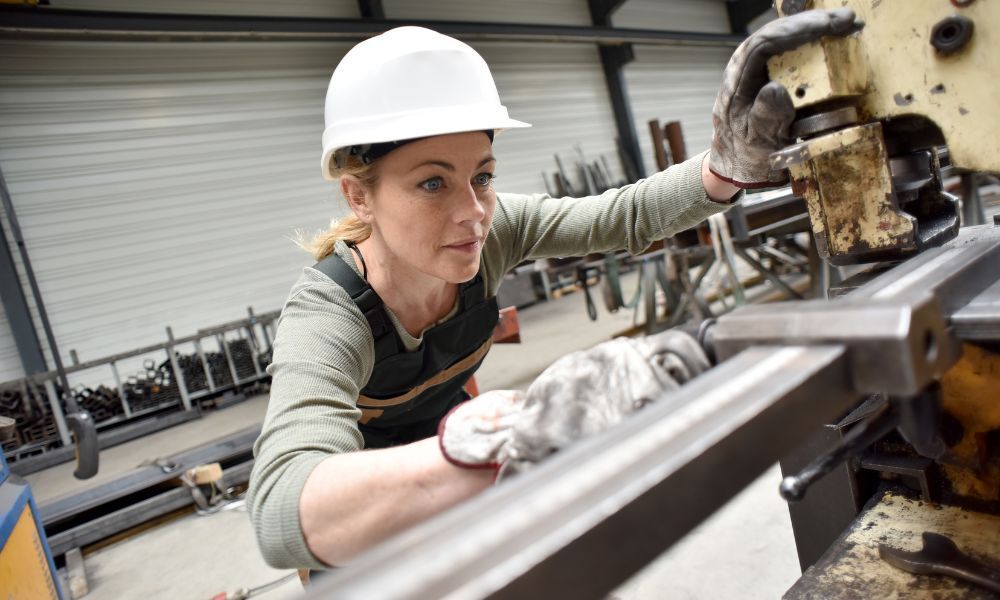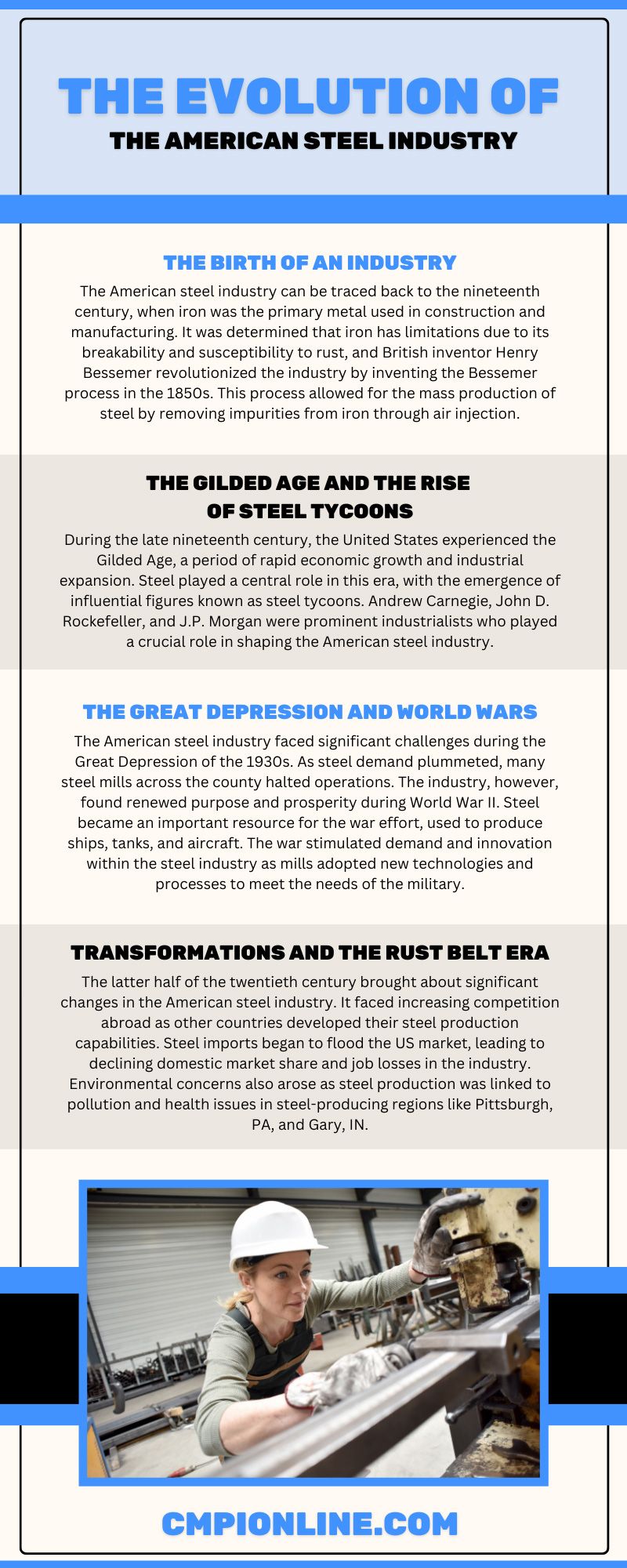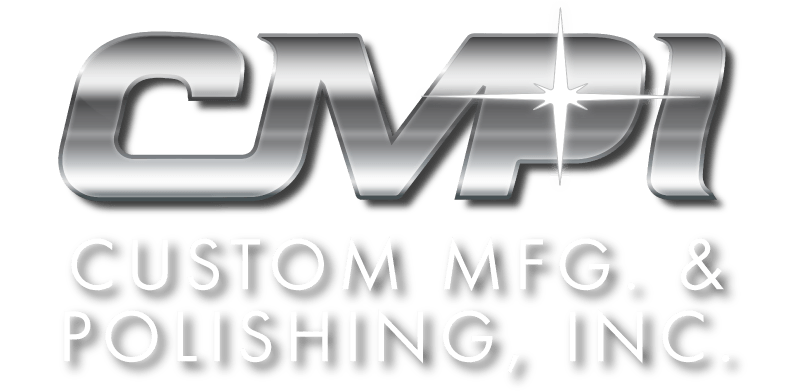The Evolution of the American Steel Industry

The American steel industry is a cornerstone of the nation’s economy, with a rich history dating back to the nineteenth century. It has been pivotal in shaping the country’s infrastructure, manufacturing capabilities, and global competitiveness. During the evolution of the American steel industry, this sector has undergone significant changes and challenges. From its humble beginnings to its present-day landscape, steel has supported hundreds of companies and employed millions.
The Birth of an Industry
The American steel industry can be traced back to the nineteenth century, when iron was the primary metal used in construction and manufacturing. It was determined that iron has limitations due to its breakability and susceptibility to rust, and British inventor Henry Bessemer revolutionized the industry by inventing the Bessemer process in the 1850s. This process allowed for the mass production of steel by removing impurities from iron through air injection.
Alexander Lyman Holley brought the Bessemer approach to the US, marking a turning point in the American steel industry’s history by enabling the production of stronger, more durable, and versatile materials. Steel became the foundation for the construction of railroads, bridges, and buildings, leading to the expansion of the nation’s infrastructure. The rapid growth of cities and the development of a transcontinental railroad system were made possible by the increased affordability and ability to make steel.
The Gilded Age and the Rise of Steel Tycoons
During the late nineteenth century, the United States experienced the Gilded Age, a period of rapid economic growth and industrial expansion. Steel played a central role in this era, with the emergence of influential figures known as steel tycoons. Andrew Carnegie, John D. Rockefeller, and J.P. Morgan were prominent industrialists who played a crucial role in shaping the American steel industry.
Andrew Carnegie, in particular, became synonymous with the American steel industry. He established the Carnegie Steel Company—which would later become US Steel—one of the largest and most influential steel corporations in history. Carnegie’s vision and the vertical integration of his company, which encompassed mining, transportation, and manufacturing, allowed him to exert significant control over the industry. This era marked a considerable concentration of wealth and power in the hands of a few as steel continued to thrive.
The Great Depression and World Wars
The American steel industry faced significant challenges during the Great Depression of the 1930s. As steel demand plummeted, many steel mills across the county halted operations. The industry, however, found renewed purpose and prosperity during World War II. Steel became an important resource for the war effort, used to produce ships, tanks, and aircraft. The war stimulated demand and innovation within the steel industry as mills adopted new technologies and processes to meet the needs of the military.
Following the end of World War II, the industry experienced a period of unprecedented growth and expansion. The post-war economic boom fueled a tremendous demand for steel as the nation invested in infrastructure, including the construction of highways, bridges, and buildings. This era of prosperity led larger corporations to dominate the landscape.
Transformations and the Rust Belt Era
The latter half of the twentieth century brought about significant changes in the American steel industry. It faced increasing competition abroad as other countries developed their steel production capabilities. Steel imports began to flood the US market, leading to declining domestic market share and job losses in the industry. Environmental concerns also arose as steel production was linked to pollution and health issues in steel-producing regions like Pittsburgh, PA, and Gary, IN.
One of the most notable events in the history of the American steel industry occurred in the 1980s, when the US steel industry experienced a severe downturn. This period, known as the Rust Belt Era, was marked by the closure of numerous steel mills and the loss of hundreds of thousands of jobs. The steel industry faced numerous challenges, including outdated facilities, high labor costs, and fierce international competition.
In response to these challenges, the American steel industry underwent significant restructuring. Many older, less efficient steel mills were closed, and companies implemented modernization efforts to enhance productivity and reduce environmental impact. Labor unions and steel companies engaged in contentious negotiations, resulting in changes to labor contracts and practices.
The Modern American Steel Industry
Today, the American steel industry has undergone a remarkable transformation. It is more technologically advanced, efficient, and environmentally conscious. Some key developments and trends in the modern American steel industry include:
- Technological advancements: The industry has embraced automation, data analytics, and robotics to improve efficiency and quality. These innovations have made steel production safer and more precise.
- Environmental concerns: Steel companies have made significant strides in reducing their ecological footprint. They have implemented cleaner production methods, reduced emissions, and adopted sustainable practices.
- Global competition: The American steel industry faces competition abroad, particularly from countries with lower labor costs. Tariffs and trade policies have been implemented to address these challenges.
- Diversification: Many steel companies have diversified their operations, producing a broader range of steel products to meet changing demands. This includes the production of high-strength steel for the automotive industry and advanced steel for aerospace applications.
- Collaboration: Collaboration between steel companies and government agencies has been instrumental in addressing challenges and supporting research and development in the industry.
- Job training and workforce development: The industry is actively investing in workforce development and training programs to ensure a skilled and adaptable workforce for the future.
- Recycling: Steel is one of the most recyclable materials in the world, and recycling efforts have become a key focus for sustainability in the industry.
The modern American steel industry is a testament to adaptability and resilience. It has weathered numerous challenges and transformations, demonstrating its continued importance to the nation’s economy and infrastructure. Today, the steel industry remains a critical player in the construction, automotive, aerospace, and energy sectors, supplying the necessary raw materials for innovation and growth.
The Future of the American Steel Industry
Looking ahead, the steel industry faces a mix of opportunities and challenges. Key factors that will shape its future include:
- Infrastructure investments
- Sustainability
- Global dynamics and policies
- Technological advancements
- Market diversity
The evolution of the American steel industry is a testament to the nation’s ability to persist. From the early days of iron to the present era of advanced materials and global competition, the industry has remained a staple of the US economy. As it faces future challenges and opportunities, the American steel industry will continue to be a symbol of adaptability and innovation, contributing to the economy of the United States.
At CMPI, we’re committed to delivering top-notch stainless steel sheet polishing services that meet the demands of today’s steel sector. Join us in shaping a sustainable, advanced, and resilient future with steel.




